Abstract
Mucopolysaccharidosis type II (MPS II, Hunter syndrome) is an X-chromosomal storage disorder due to deficiency of the lysosomal enzyme iduronate-2-sulfatase (IDS). We have identified IDS mutations in a total of 31 families/patients with MPS II, of which 20 are novel and unique and a further 1 is novel but has been found in 3 unrelated patients. One of the mutations detected is of special interest as an AG-->G substitution in an intron, far apart from the coding region, is deleterious by creating a new 5'-splice-donor site that results in the inclusion of a 78-bp intronic sequence. While the distribution of gene rearrangements (deletions, insertions, and duplications) of <20 bp seems to be random over the IDS gene, the analysis of a total of 101 point mutations lying within the coding region shows that they tend to be more frequent in exons III, VIII, and IX. Forty-seven percent of the point mutations are at CpG dinucleotides, of which G:C-to-A:T transitions constitute nearly 80%. Almost all recurrent point mutations involve CpG sites. Analysis of a collective of 50 families studied in our laboratory, to date, revealed that mutations occur more frequently in male meioses (estimated male-to-female ratio between 3.76 and 6.3).
Full text
PDF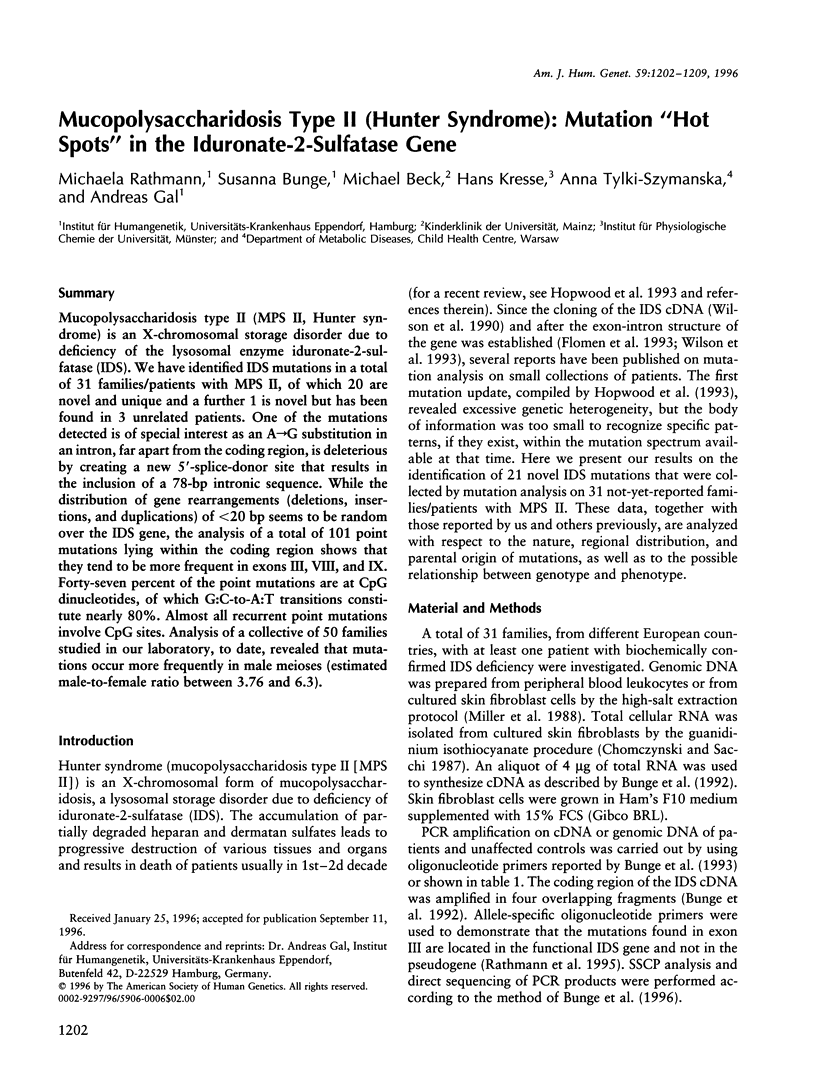
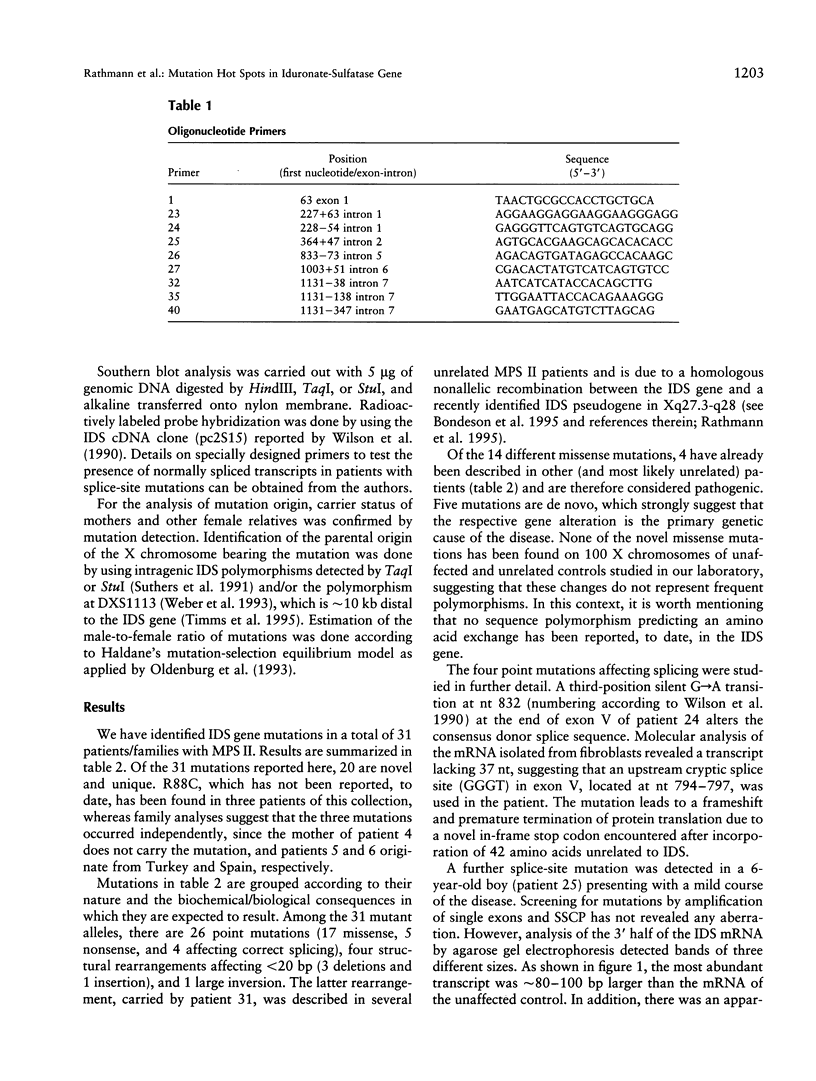
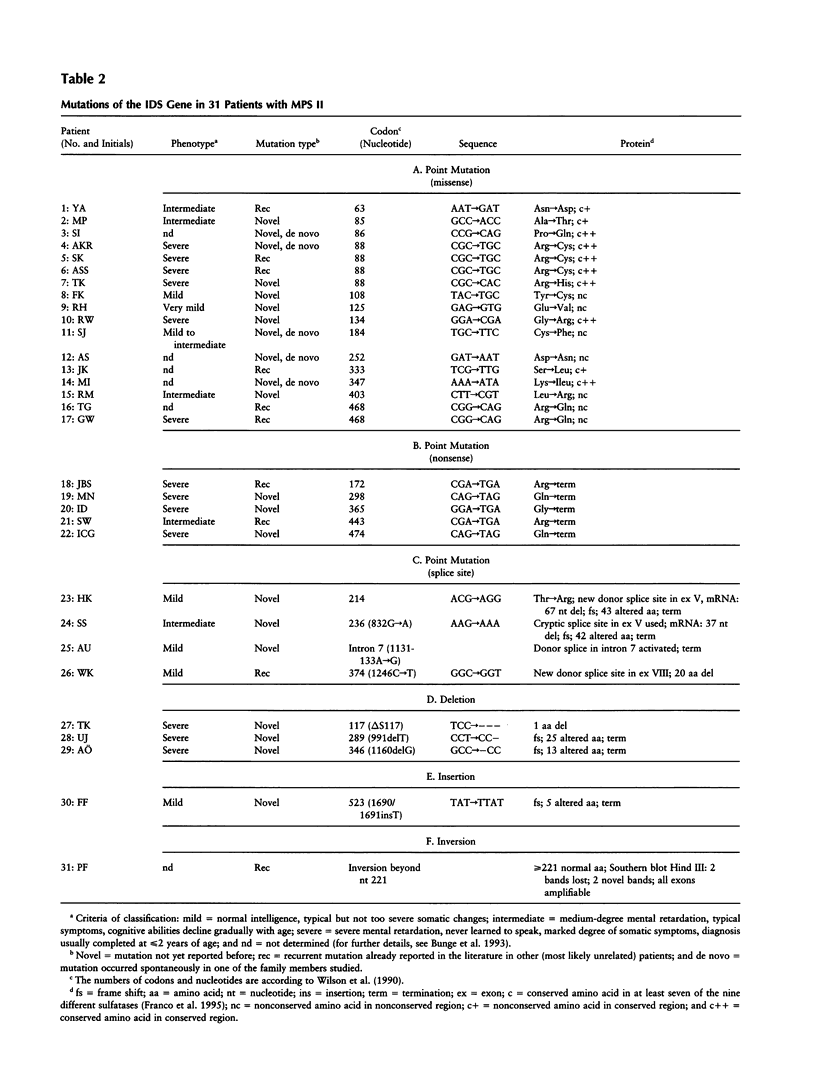
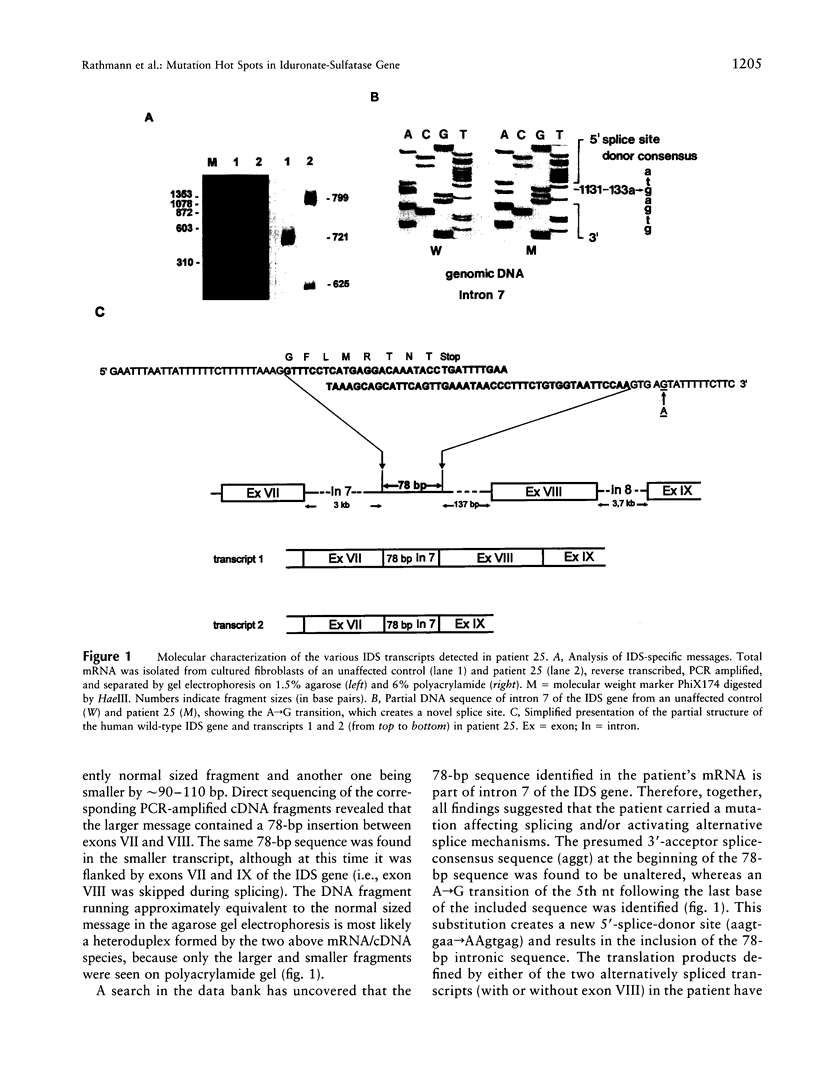
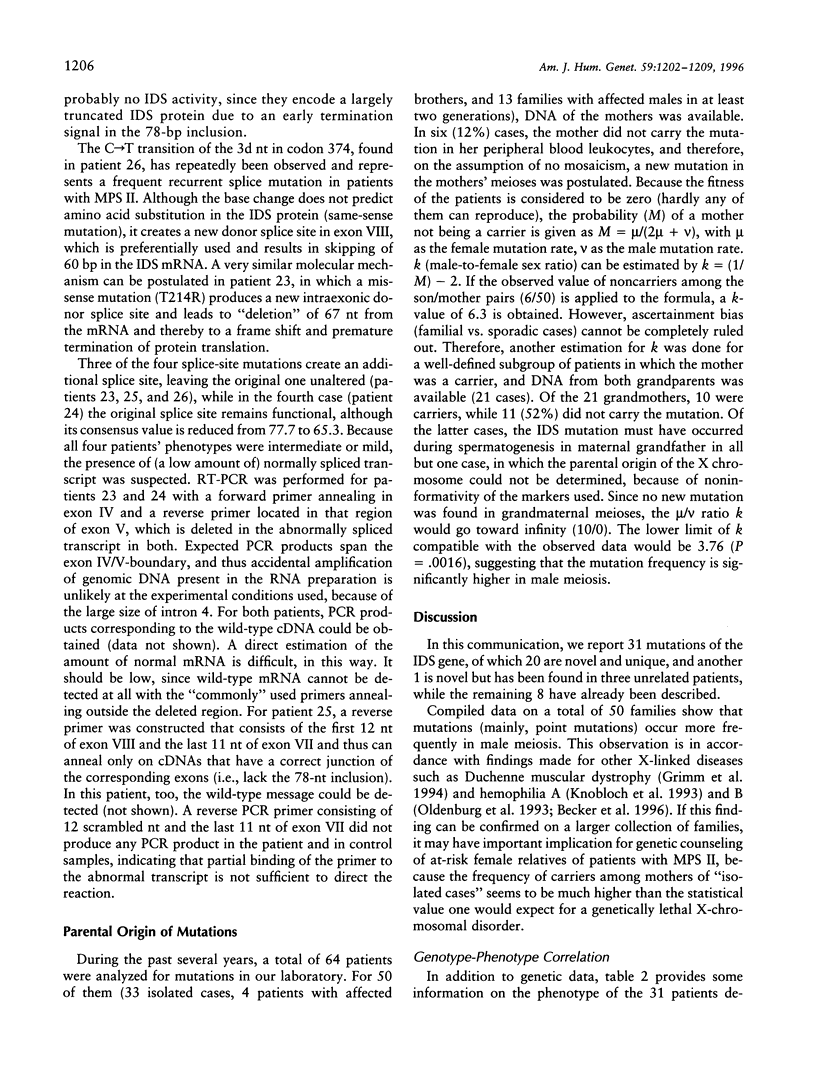
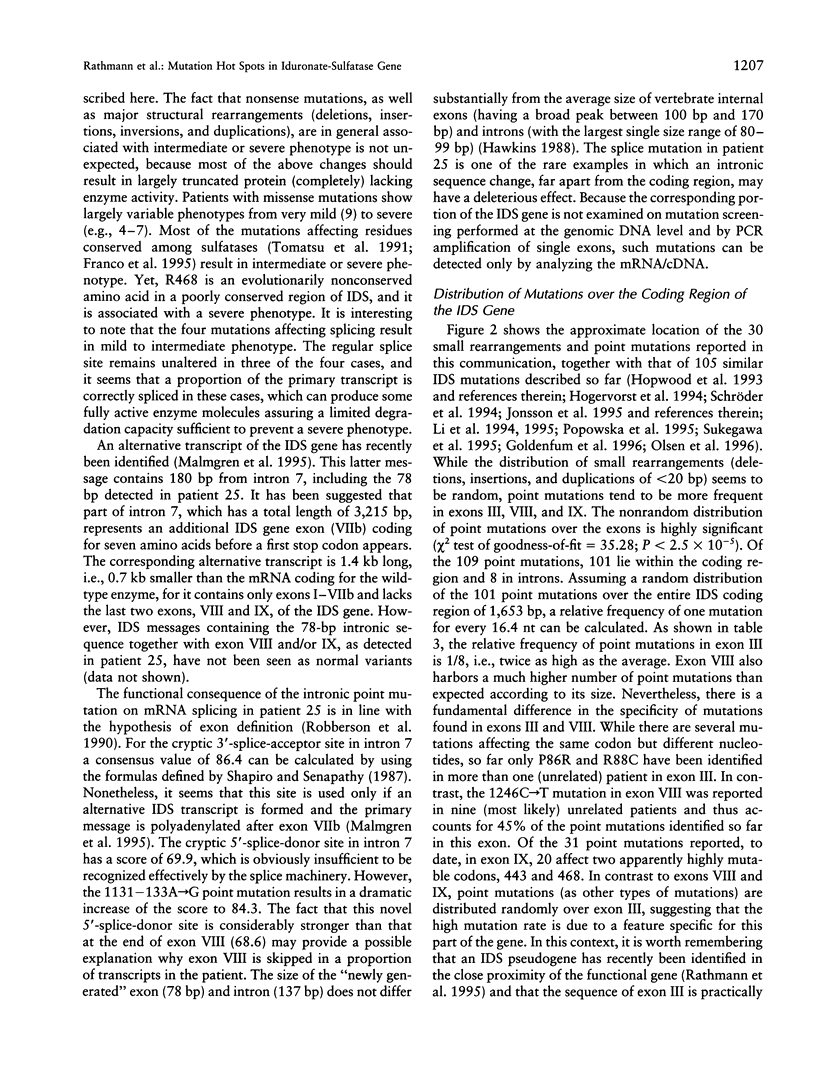
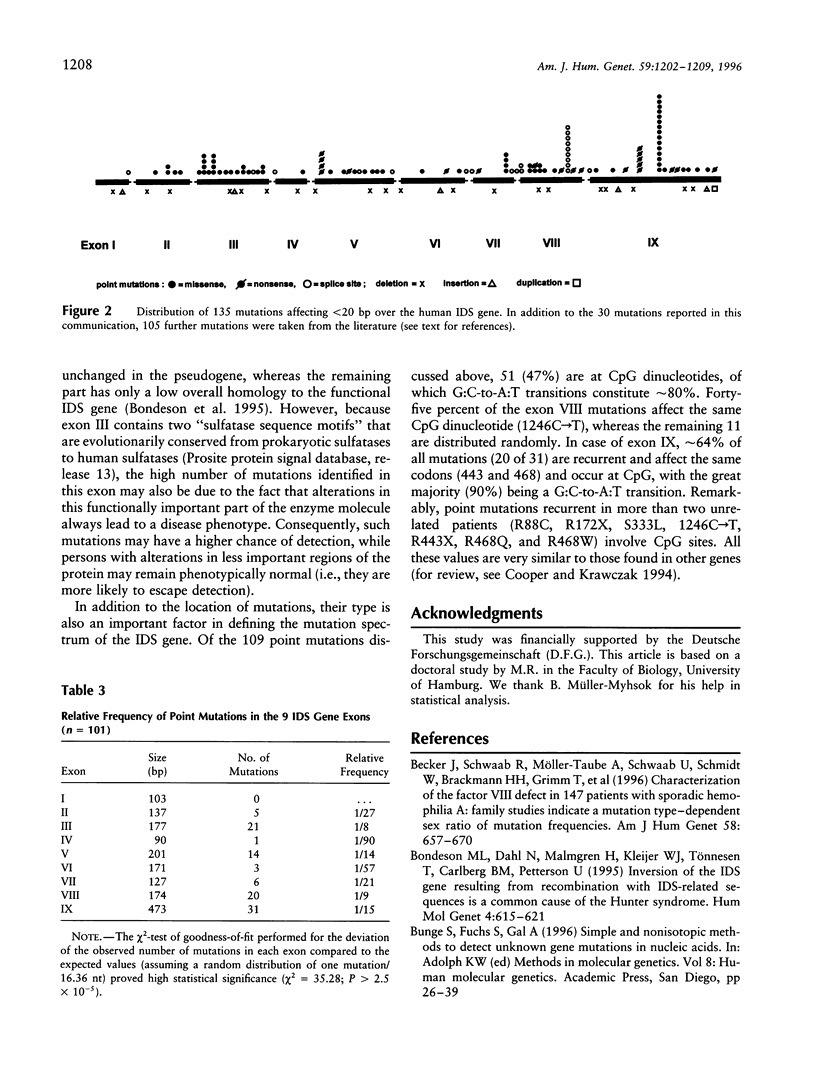
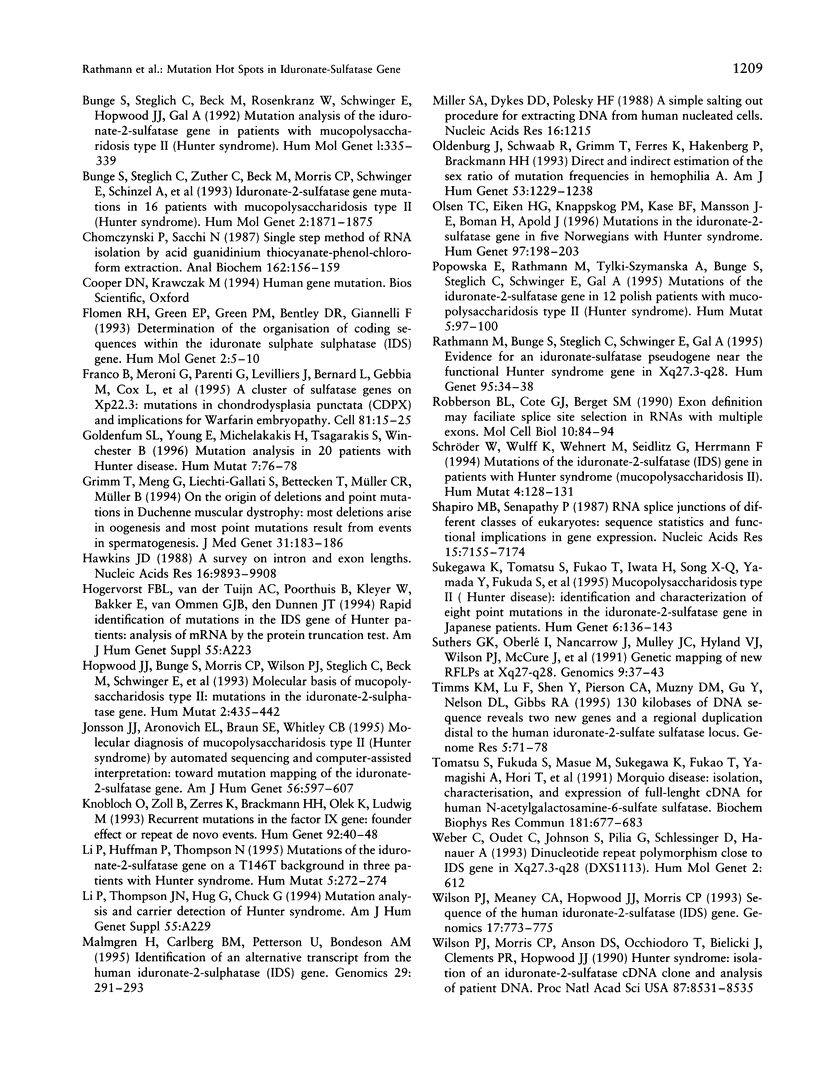
Images in this article
Selected References
These references are in PubMed. This may not be the complete list of references from this article.
- Becker J., Schwaab R., Möller-Taube A., Schwaab U., Schmidt W., Brackmann H. H., Grimm T., Olek K., Oldenburg J. Characterization of the factor VIII defect in 147 patients with sporadic hemophilia A: family studies indicate a mutation type-dependent sex ratio of mutation frequencies. Am J Hum Genet. 1996 Apr;58(4):657–670. [PMC free article] [PubMed] [Google Scholar]
- Bondeson M. L., Dahl N., Malmgren H., Kleijer W. J., Tönnesen T., Carlberg B. M., Pettersson U. Inversion of the IDS gene resulting from recombination with IDS-related sequences is a common cause of the Hunter syndrome. Hum Mol Genet. 1995 Apr;4(4):615–621. doi: 10.1093/hmg/4.4.615. [DOI] [PubMed] [Google Scholar]
- Bunge S., Steglich C., Beck M., Rosenkranz W., Schwinger E., Hopwood J. J., Gal A. Mutation analysis of the iduronate-2-sulfatase gene in patients with mucopolysaccharidosis type II (Hunter syndrome). Hum Mol Genet. 1992 Aug;1(5):335–339. doi: 10.1093/hmg/1.5.335. [DOI] [PubMed] [Google Scholar]
- Bunge S., Steglich C., Zuther C., Beck M., Morris C. P., Schwinger E., Schinzel A., Hopwood J. J., Gal A. Iduronate-2-sulfatase gene mutations in 16 patients with mucopolysaccharidosis type II (Hunter syndrome). Hum Mol Genet. 1993 Nov;2(11):1871–1875. doi: 10.1093/hmg/2.11.1871. [DOI] [PubMed] [Google Scholar]
- Chomczynski P., Sacchi N. Single-step method of RNA isolation by acid guanidinium thiocyanate-phenol-chloroform extraction. Anal Biochem. 1987 Apr;162(1):156–159. doi: 10.1006/abio.1987.9999. [DOI] [PubMed] [Google Scholar]
- Franco B., Meroni G., Parenti G., Levilliers J., Bernard L., Gebbia M., Cox L., Maroteaux P., Sheffield L., Rappold G. A. A cluster of sulfatase genes on Xp22.3: mutations in chondrodysplasia punctata (CDPX) and implications for warfarin embryopathy. Cell. 1995 Apr 7;81(1):15–25. doi: 10.1016/0092-8674(95)90367-4. [DOI] [PubMed] [Google Scholar]
- Goldenfum S. L., Young E., Michelakakis H., Tsagarakis S., Winchester B. Mutation analysis in 20 patients with Hunter disease. Hum Mutat. 1996;7(1):76–78. doi: 10.1002/(SICI)1098-1004(1996)7:1<76::AID-HUMU14>3.0.CO;2-P. [DOI] [PubMed] [Google Scholar]
- Grimm T., Meng G., Liechti-Gallati S., Bettecken T., Müller C. R., Müller B. On the origin of deletions and point mutations in Duchenne muscular dystrophy: most deletions arise in oogenesis and most point mutations result from events in spermatogenesis. J Med Genet. 1994 Mar;31(3):183–186. doi: 10.1136/jmg.31.3.183. [DOI] [PMC free article] [PubMed] [Google Scholar]
- Hawkins J. D. A survey on intron and exon lengths. Nucleic Acids Res. 1988 Nov 11;16(21):9893–9908. doi: 10.1093/nar/16.21.9893. [DOI] [PMC free article] [PubMed] [Google Scholar]
- Hopwood J. J., Bunge S., Morris C. P., Wilson P. J., Steglich C., Beck M., Schwinger E., Gal A. Molecular basis of mucopolysaccharidosis type II: mutations in the iduronate-2-sulphatase gene. Hum Mutat. 1993;2(6):435–442. doi: 10.1002/humu.1380020603. [DOI] [PubMed] [Google Scholar]
- Jonsson J. J., Aronovich E. L., Braun S. E., Whitley C. B. Molecular diagnosis of mucopolysaccharidosis type II (Hunter syndrome) by automated sequencing and computer-assisted interpretation: toward mutation mapping of the iduronate-2-sulfatase gene. Am J Hum Genet. 1995 Mar;56(3):597–607. [PMC free article] [PubMed] [Google Scholar]
- Knobloch O., Zoll B., Zerres K., Brackmann H. H., Olek K., Ludwig M. Recurrent mutations in the factor IX gene: founder effect or repeat de novo events. Investigation of the German haemophilia B population and review of de novo mutations. Hum Genet. 1993 Aug;92(1):40–48. doi: 10.1007/BF00216143. [DOI] [PubMed] [Google Scholar]
- Li P., Huffman P., Thompson J. N. Mutations of the iduronate-2-sulfatase gene on a T146T background in three patients with Hunter syndrome. Hum Mutat. 1995;5(3):272–274. doi: 10.1002/humu.1380050314. [DOI] [PubMed] [Google Scholar]
- Malmgren H., Carlberg B. M., Pettersson U., Bondeson M. L. Identification of an alternative transcript from the human iduronate-2-sulfatase (IDS) gene. Genomics. 1995 Sep 1;29(1):291–293. doi: 10.1006/geno.1995.1249. [DOI] [PubMed] [Google Scholar]
- Miller S. A., Dykes D. D., Polesky H. F. A simple salting out procedure for extracting DNA from human nucleated cells. Nucleic Acids Res. 1988 Feb 11;16(3):1215–1215. doi: 10.1093/nar/16.3.1215. [DOI] [PMC free article] [PubMed] [Google Scholar]
- Oldenburg J., Schwaab R., Grimm T., Zerres K., Hakenberg P., Brackmann H. H., Olek K. Direct and indirect estimation of the sex ratio of mutation frequencies in hemophilia A. Am J Hum Genet. 1993 Dec;53(6):1229–1238. [PMC free article] [PubMed] [Google Scholar]
- Olsen T. C., Eiken H. G., Knappskog P. M., Kase B. F., Månsson J. E., Boman H., Apold J. Mutations in the iduronate-2-sulfatase gene in five Norwegians with Hunter syndrome. Hum Genet. 1996 Feb;97(2):198–203. doi: 10.1007/BF02265265. [DOI] [PubMed] [Google Scholar]
- Popowska E., Rathmann M., Tylki-Szymanska A., Bunge S., Steglich C., Schwinger E., Gal A. Mutations of the iduronate-2-sulfatase gene in 12 Polish patients with mucopolysaccharidosis type II (Hunter syndrome). Hum Mutat. 1995;5(1):97–100. doi: 10.1002/humu.1380050114. [DOI] [PubMed] [Google Scholar]
- Rathmann M., Bunge S., Steglich C., Schwinger E., Gal A. Evidence for an iduronate-sulfatase pseudogene near the functional Hunter syndrome gene in Xq27.3-q28. Hum Genet. 1995 Jan;95(1):34–38. doi: 10.1007/BF00225070. [DOI] [PubMed] [Google Scholar]
- Robberson B. L., Cote G. J., Berget S. M. Exon definition may facilitate splice site selection in RNAs with multiple exons. Mol Cell Biol. 1990 Jan;10(1):84–94. doi: 10.1128/mcb.10.1.84. [DOI] [PMC free article] [PubMed] [Google Scholar]
- Schröder W., Wulff K., Wehnert M., Seidlitz G., Herrmann F. H. Mutations of the iduronate-2-sulfatase (IDS) gene in patients with Hunter syndrome (mucopolysaccharidosis II). Hum Mutat. 1994;4(2):128–131. doi: 10.1002/humu.1380040206. [DOI] [PubMed] [Google Scholar]
- Shapiro M. B., Senapathy P. RNA splice junctions of different classes of eukaryotes: sequence statistics and functional implications in gene expression. Nucleic Acids Res. 1987 Sep 11;15(17):7155–7174. doi: 10.1093/nar/15.17.7155. [DOI] [PMC free article] [PubMed] [Google Scholar]
- Sukegawa K., Tomatsu S., Fukao T., Iwata H., Song X. Q., Yamada Y., Fukuda S., Isogai K., Orii T. Mucopolysaccharidosis type II (Hunter disease): identification and characterization of eight point mutations in the iduronate-2-sulfatase gene in Japanese patients. Hum Mutat. 1995;6(2):136–143. doi: 10.1002/humu.1380060206. [DOI] [PubMed] [Google Scholar]
- Suthers G. K., Oberlé I., Nancarrow J., Mulley J. C., Hyland V. J., Wilson P. J., McCure J., Morris C. P., Hopwood J. J., Mandel J. L. Genetic mapping of new RFLPs at Xq27-q28. Genomics. 1991 Jan;9(1):37–43. doi: 10.1016/0888-7543(91)90218-4. [DOI] [PubMed] [Google Scholar]
- Timms K. M., Lu F., Shen Y., Pierson C. A., Muzny D. M., Gu Y., Nelson D. L., Gibbs R. A. 130 kb of DNA sequence reveals two new genes and a regional duplication distal to the human iduronate-2-sulfate sulfatase locus. Genome Res. 1995 Aug;5(1):71–78. doi: 10.1101/gr.5.1.71. [DOI] [PubMed] [Google Scholar]
- Tomatsu S., Fukuda S., Masue M., Sukegawa K., Fukao T., Yamagishi A., Hori T., Iwata H., Ogawa T., Nakashima Y. Morquio disease: isolation, characterization and expression of full-length cDNA for human N-acetylgalactosamine-6-sulfate sulfatase. Biochem Biophys Res Commun. 1991 Dec 16;181(2):677–683. doi: 10.1016/0006-291x(91)91244-7. [DOI] [PubMed] [Google Scholar]
- Weber C., Oudet C., Johnson S., Pilia G., Schlessinger D., Hanauer A. Dinucleotide repeat polymorphism close to IDS gene in Xq27.3-q28 (DXS1113). Hum Mol Genet. 1993 May;2(5):612–612. doi: 10.1093/hmg/2.5.612-a. [DOI] [PubMed] [Google Scholar]
- Wilson P. J., Meaney C. A., Hopwood J. J., Morris C. P. Sequence of the human iduronate 2-sulfatase (IDS) gene. Genomics. 1993 Sep;17(3):773–775. doi: 10.1006/geno.1993.1406. [DOI] [PubMed] [Google Scholar]
- Wilson P. J., Morris C. P., Anson D. S., Occhiodoro T., Bielicki J., Clements P. R., Hopwood J. J. Hunter syndrome: isolation of an iduronate-2-sulfatase cDNA clone and analysis of patient DNA. Proc Natl Acad Sci U S A. 1990 Nov;87(21):8531–8535. doi: 10.1073/pnas.87.21.8531. [DOI] [PMC free article] [PubMed] [Google Scholar]



